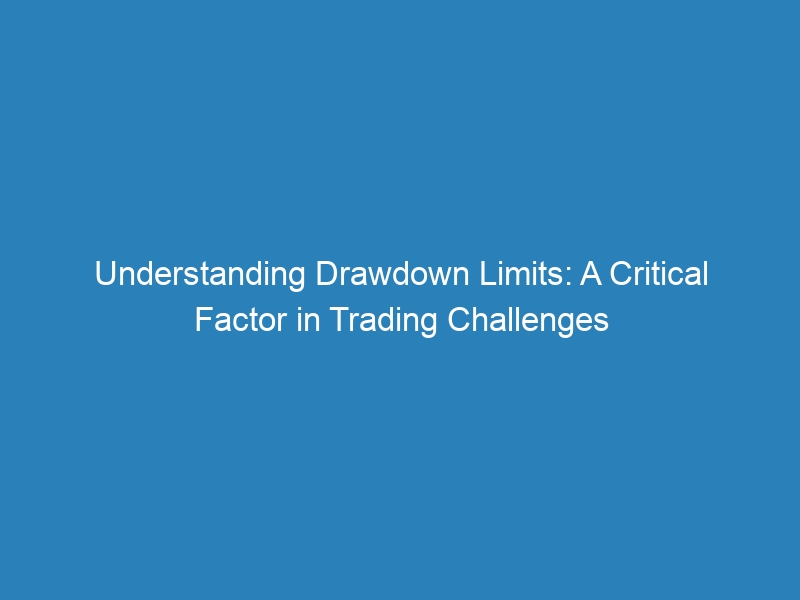Understanding Drawdown Limits: A Critical Factor in Trading Challenges

In the world of trading, drawdown limits serve a critical function in safeguarding your investments and informing your strategies. These limits specify the maximum permissible decline in a portfolio’s value, aiding traders in navigating the frequently volatile and unpredictable market landscape.
It is essential for you to understand how drawdown limits interact with factors such as market volatility, trading strategies, and risk management. This knowledge is key to maintaining both profitability and psychological resilience.
This article will delve into the importance of drawdown limits, their effect on performance, and effective strategies for managing them, ensuring you are well-prepared to face the challenges of trading.
What is a Drawdown Limit?
A drawdown limit is an essential risk management tool for you as a trader, helping to define the maximum acceptable loss in your trading portfolio over a specific period. This limit is designed to protect your capital and ensure that you maintain control over your emotions and decision-making processes during market fluctuations.
By establishing a clear drawdown limit, you can effectively navigate various market conditions without letting fear or greed cloud your judgment. This disciplined approach fosters capital preservation, encouraging you to stick to your trading plans rather than giving in to impulsive reactions.
In essence, a well-defined drawdown limit give the power tos you to maintain your composure, promoting a consistent strategy that aligns with your risk tolerance and overall financial goals. Consequently, it becomes a fundamental element in fostering trading discipline, enabling you to achieve more sustainable growth over time and ultimately enhancing your ability to withstand the inevitable ups and downs of the markets.
Why it is Important in Trading
Understanding the importance of drawdown limits in trading is crucial for any trader aiming for long-term success in financial markets. These limits act as a safeguard for your trading capital, enabling you to manage risk effectively and avoid significant losses that could jeopardize your investment goals.
By implementing a drawdown limit, you also develop emotional control, which is essential for maintaining trading discipline and making rational decisions during periods of market volatility. Consequently, this strategy can lead to improved risk-adjusted returns and enhance overall trading performance.
Incorporating drawdown limits into your trading strategies not only emphasizes the adherence to your trading objectives but also supports a thorough risk assessment process. Traders who establish clear boundaries regarding their acceptable losses are better positioned to navigate the unpredictable nature of the markets.
This proactive approach helps preserve capital, ensuring that even in challenging situations, you can continue pursuing profitable opportunities without giving in to impulsive decisions driven by fear or greed.
Ultimately, drawdown limits give the power to you to concentrate on your long-term goals, fostering a disciplined and strategic mindset that is essential for navigating the complexities of financial trading.
Factors that Influence Drawdown Limits
Several factors significantly influence the establishment of drawdown limits in trading, impacting your overall success and risk exposure in the financial markets.
These factors include market volatility, which can lead to sudden price swings, and your individual trading strategies that dictate how much risk you are willing to take.
Additionally, considerations related to market conditions, your experience level as a trader, and psychological barriers are crucial in shaping effective drawdown limits.
Therefore, understanding these factors is essential for optimizing drawdown recovery and enhancing your trading performance.
Market Volatility
Market volatility is a crucial factor that influences drawdown limits, as it defines the degree of price fluctuations in financial markets over a specific period. High volatility often leads to larger and more unpredictable price movements, increasing risk exposure for traders.
This situation necessitates the establishment of tighter drawdown limits to protect capital and manage losses effectively. By understanding the relationship between volatility and drawdown, you can adapt your trading strategies accordingly, ensuring that you maintain a favorable risk-reward ratio in the face of market fluctuations.
For example, during periods of heightened volatility, such as when economic reports are released or geopolitical events occur, it may be prudent to adjust your entry and exit points to be more conservative. This could involve implementing smaller position sizes or widening stop-loss orders to accommodate unexpected price swings, thus preserving your trading performance.
Conversely, in more stable market conditions, you might feel confident enough to relax your drawdown limits, potentially allowing for greater capital exposure and larger positions.
By continually assessing market volatility, you can optimize your risk management practices, ensuring that your strategies remain robust and effective, regardless of external influences.
Trading Strategy
The choice of trading strategy significantly influences the appropriate drawdown limits for you as a trader, given that different strategies carry varying levels of risk and potential returns.
A well-defined trading strategy should include entry and exit points, position sizing, and risk management rules, all of which play a crucial role in determining how you set your drawdown limits.
By incorporating performance metrics and backtesting results, you can establish realistic drawdown thresholds that align with your investment objectives while prioritizing capital preservation.
Understanding the relationship between trading strategies and risk-reward ratios is essential, as it enables you to manage potential losses effectively while also capitalizing on profitable opportunities.
Implementing strict trading rules fosters a disciplined approach, which helps minimize emotional decision-making that can lead to overtrading or poor judgment during market fluctuations.
Backtesting various strategies against historical data allows you to evaluate their effectiveness and identify any necessary adjustments to enhance performance. This process reinforces the importance of diligent risk management, ensuring your long-term success in the dynamic world of trading.
Risk Management
Effective risk management is essential for determining drawdown limits, significantly influencing your ability to minimize losses and optimize capital allocation in your trading activities.
By implementing robust risk management techniques, such as position sizing and stop-loss orders, you can set drawdown limits that align with your risk tolerance and trading objectives. Continuous evaluation and adjustment of these limits will help you remain adaptable to changing market conditions while preserving the integrity of your investment strategies.
These strategies not only protect your capital but also facilitate effective tracking of risk exposure, enabling timely decisions that can mitigate potential downturns. Along with basic metrics, you can utilize advanced tools like volatility measures and Value at Risk (VaR) calculations to deepen your understanding of market dynamics. Establishing clear rules regarding risk-reward ratios fosters trading discipline, ensuring that you adhere closely to your well-defined limits.
In this manner, setting drawdown limits becomes a crucial component of your overall risk management framework, intricately connected to your long-term success.
The Impact of Drawdown Limits on Trading Performance
The implementation of drawdown limits can significantly impact your trading performance, influencing both profitability and your psychological resilience in volatile market conditions.
By adhering to established drawdown thresholds, you can minimize emotional control challenges, thereby reducing the likelihood of impulsive trading decisions that often lead to further losses.
Additionally, a well-defined drawdown strategy aids in loss mitigation while enhancing profit maximization opportunities.
This allows you to focus on your long-term investment goals without succumbing to short-term market pressures.
How it Affects Profitability
Drawdown limits are essential in determining the overall profitability of your trading strategy, as they establish the amount of capital you are willing to risk before reassessing your approach. When set effectively, these limits protect your capital, allowing you to pursue profitable opportunities without depleting your resources.
By implementing drawdown limits, you are encouraged to adopt a disciplined approach to profit targets, focusing on long-term success instead of being lured by short-term gains.
Integrating drawdown limits into your risk management framework can help cultivate an environment of financial security, enabling you to analyze your trading performance with clarity. This proactive strategy minimizes emotional decision-making during volatile market conditions and streamlines the evaluation process, making it easier to pinpoint inefficiencies or areas for improvement.
Ultimately, maintaining a balance between prudent risk management and aggressive profit-seeking can enhance your overall returns while safeguarding against unforeseen losses, fostering a sustainable trading practice that can succeed in various market environments.
The Psychological Aspect
The psychological impact of drawdown limits is significant, as they directly influence your emotional control and decision-making abilities during market fluctuations. By setting clear drawdown limits, you position yourself to manage the stress associated with potential losses more effectively.
These limits create a structured framework for your trading activities, fostering a disciplined approach that helps you navigate the emotional barriers that can hinder performance and lead to costly mistakes.
Understanding these psychological aspects enables you to cultivate greater psychological resilience. This resilience allows you to accept losses without letting them cloud your judgment or prompt impulsive decisions. Maintaining this resilience is essential for a consistent approach to your trading systems, ensuring that personal emotions do not overshadow analytical thinking.
By adhering to established drawdown limits, you can minimize anxiety, bolster your confidence, and ultimately enhance your overall trading experience, paving the way for long-term success.
Strategies for Managing Drawdown Limits
Implementing effective strategies for managing drawdown limits is essential for you as a trader aiming to enhance your risk management techniques and overall trading performance.
These strategies may include:
- Diversifying your assets
- Practicing careful position sizing
- Establishing stop-loss orders to protect your capital during adverse market conditions
By maintaining trading discipline and exercising emotional control, you can ensure that your drawdown limits fulfill their intended purpose without undermining your long-term profitability and investment growth.
Diversification
Diversification is a fundamental strategy for managing drawdown limits, as it helps you spread risk across various financial instruments and trading strategies. By diversifying your portfolio, you can reduce the impact of adverse market fluctuations on your overall capital, resulting in more stable performance metrics. This approach not only mitigates risk exposure but also enhances your potential for profit maximization, allowing you to adhere to your drawdown limits more effectively.
Implementing diversification involves allocating your resources among different asset classes, such as stocks, bonds, and commodities, while also considering varying market trends and economic conditions. By engaging with a broader range of trades, you can effectively manage risk and optimize your performance evaluation, ensuring that no single investment dramatically affects your overall returns.
Employing various trading strategies—such as combining long-term investments with short-term trades—further supports this method. As market scenarios evolve, this strategic spread can safeguard you from significant losses, ultimately aligning your trading activities with robust risk management practices.
Position Sizing
Position sizing is a crucial factor in managing your drawdown limits, as it influences how much capital you allocate to each trade based on your specific risk tolerance and overall trading strategy.
By carefully determining the size of each position, you can ensure that you stay within your drawdown thresholds, ultimately protecting your capital and supporting long-term financial security. Effective position sizing not only helps you manage risk but also enhances your overall trading discipline and emotional control.
It serves as a foundational component of risk management, allowing you to make informed decisions that align with your trading systems.
For instance, if you employ a conservative approach, you might select smaller positions to mitigate potential losses, thereby adhering to your predefined limits. Conversely, if you adopt a more aggressive strategy, you may allocate larger portions of your capital when you feel confident in market conditions.
Techniques such as the Kelly Criterion can be instrumental in optimizing your position sizing by calculating the ideal bet size based on expected returns and probabilities.
Ultimately, mastering position sizing is vital for improving your trading performance, fostering resilience in volatile markets, and facilitating a more sustainable trading journey.
Stop Loss Orders
Stop-loss orders are essential tools for managing drawdown limits, as they automatically close trades when prices reach predetermined levels, thereby protecting you from excessive losses. By integrating stop-loss strategies into your trading plans, you can effectively manage risk and adhere to your drawdown limits, enhancing your overall trade execution and decision-making processes.
This approach not only fosters discipline in your trading activities but also ensures that you can maintain your focus on long-term performance and investment goals.
Understanding the different types of stop-loss orders, such as fixed, trailing, and market stop-losses, allows you to tailor your strategies to your individual risk tolerance and market conditions. Implementing these orders with a disciplined mindset will help fortify your emotional control during periods of volatility—an essential aspect of successful risk management.
As you navigate complex market landscapes, having clearly defined stop-loss parameters becomes crucial for sustaining trading performance, mitigating drawdowns, and ultimately preserving your capital over the long haul. Therefore, adopting best practices in stop-loss implementation not only safeguards your assets but also give the power tos you to make informed, rational decisions in pursuit of your financial aspirations.
Frequently Asked Questions
What are drawdown limits and why are they important in trading?
Drawdown limits refer to the maximum amount of capital that a trader is willing to lose before exiting a trade. They are important because they help manage risk and prevent substantial losses in trading.
How do drawdown limits impact trading challenges?
Drawdown limits play a critical role in trading challenges as they can determine the success or failure of a trader. A well-defined drawdown limit can help traders avoid emotional decision-making and stick to their trading strategy, even during difficult market conditions.
How can I determine my drawdown limit?
Determining your drawdown limit depends on your risk tolerance and trading style. It is recommended to only risk a small percentage of your capital per trade, typically 1-2%, and set a maximum drawdown limit of 5-10% of your total capital.
What happens if I exceed my drawdown limit?
If you exceed your drawdown limit, it is important to re-evaluate your trading strategy and make necessary adjustments. It is also advisable to take a break from trading to avoid further losses and regain a clear mindset.
Are there any tools or techniques to help monitor drawdown limits?
Yes, there are various tools and techniques available to help traders monitor and manage their drawdown limits. These include stop loss orders, position sizing, and keeping a trading journal to track performance and identify patterns.
Can drawdown limits be adjusted or changed?
Yes, drawdown limits can be adjusted or changed depending on market conditions, risk tolerance, and trading goals. It is important to regularly review and update drawdown limits to align with your overall trading strategy and objectives.
Understanding Drawdown Limits: In the world of prop trading, managing drawdown is critical to success. Mastering Understanding Drawdown Limits can help you navigate the strict requirements of prop firm challenges while maintaining consistent profitability. Let’s explore how successful traders manage their drawdown effectively.


Recent Comments